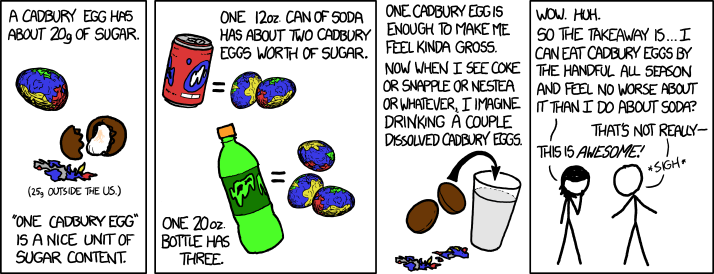Candy: A Century of Panic and Pleasure by Samira Kawash
Reviewed by Loralee Leavitt
Halloween math doesn’t add up. Children trick-or-treat at office parties, church events, and neighborhoods, celebrating Halloween by maximizing candy collection. But many parents don’t want their children actually eating that much candy. They buy it back, trade it for toys, throw it away, or turn it into dazzling science experiments. Some protect their children by baking the candy into holiday sweets, sending it to the office, donating it to the homeless, or mailing it to troops overseas, so that instead of removing calories from circulation, they’re merely transferring them. What a twisted love/hate relationship we have with our sweets!
According to Samira Kawash, author of Candy: A Century of Panic and Pleasure, this ambivalence is nothing new. Her new book covers the recent history of candy, starting in the 1800’s before mass production kicked off the candy industry. From a very occasional holiday treat, candy became a national phenomenon with households and small factories producing thousands of varieties for their local markets (many went under because, as confectioners instead of accountants, they couldn’t reconcile cost with income), only to go under as aggressive businessmen consolidated holdings and marketed brands in national campaigns.
As I read, I was constantly reminded that brand success depends far more on marketing than it does on the pure merits of the product. Kawash walks us through the early growth of the candy industry, as it developed from thousands of small-business home-cooks to bigger companies that figured out successful naming and marketing strategies. (Babe Ruth was not allowed to profit from the success of the candy bar supposedly NOT named after him, nor to put his own name on a similar bar.) Candy marketers attempted to incorporate the latest scientific findings, so that early on in candy’s history, when all carbohydrates were thought to be equal, ads proclaimed “Candy is delicious food, enjoy some every day,” or tried to paint dextrose as a healthier form of sugar. Candy even became a target of the burgeoning cigarette industry with Lucky’s campaign: “Reach for a Lucky instead of a sweet.”
As candy became part of the national culture, so did candy detractors. Periodic panics about candy reflected our country’s uneasiness about mass production, sanitation, artificial ingredients, and pure pleasure. One early dieter wrote in religious terms, equating indulgence with sin, and the follow-up with repentance, a mindset which seems to have worked its way into the national psyche. Candy was also thought by some intellectuals with (not enough) knowledge of chemistry to behave like alcohol when ingested, since it was broken down into similar component carbohydrates. In fact, the current debates about candy--how to avoid it, how much it contributes to obesity, and whether or not children should eat it or not--have actually been cycling through public discourse for over 100 years.
Some candy mythology gets debunked along the way. Kawash tackles our fear of adulterated Halloween candy with the news that there has never been an authenticated case of a villain passing out deadly candy to trick-or-treaters. (To be complete, she does cite an occasion in 1959 when a grumpy doctor coated candies in laxatives, or a time when a small child shoved a pin in his own candy and showed his parents so he could blame his neighbors, or times when children’s deaths were wrongly blamed on tainted candy because parents were manufacturing evidence to clear themselves of crime.) Kawash also takes on the recent research about chocolate’s fabulous health benefits by pointing out that the research is mostly industry-funded, and often tests chocolate in forms we don’t actually eat. (Personally, though, I’d rather believe ALL of the positive findings and use chocolate as my daily vitamin!)
Speaking of vitamins, Kawash points out something that I have also noticed in my years of writing about candy: we worry about genuine candy, but don’t recognized how many other new types of “food” really also qualify as candy, such as gummi vitamins. The Kellog’s snack bars at Costco reminded me of the chapter in which we learn that most candy companies missed the boat when it came to candification: it was companies like cereal manufacturers who “candified” breakfast cereal, created the “granola” bars that are really candy bars in disguise, or turned fruit into “fruit snacks” indistinguishable from their gummy candy counterparts. Snickers, with their “Packed with peanuts” slogan, was one rare exception.
Kawash closes with an appeal for common-sense candy eating. Avoid the “candy” that masquerades as cereal, snack bars, or drinks. Avoid the other highly-processed foods that also contribute to our national obesity epidemic. Eat real food, good food. And when you want a treat, eat candy.
(Note: this copy was sent to me, free of charge, for review, after I requested it. Since I’d followed Kawash’s blog at candyprofessor.com for awhile, I was really excited about the book.)
(Another note: I love Kawash’s transitions. Ever chapter leads nicely into the next chapter, almost like a Nancy Drew cliffhanger!)



































.jpg)













